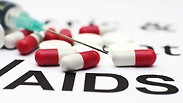
Israel sees rise in HIV infections among gays
Despite drop in general number of HIV cases, Health Ministry reports increase in infection rate in LGBT community for second year in a row.
The official figure does not match a recent report issued by the National Center for AIDS Confirmation Tests, which pointed to a rise in HIV infections with 495 new cases in 2013.
The Healthy Ministry figures point to a drop in the number of new HIV cases diagnosed among people who arrived from countries where the virus is more common, from 115 to 90.
A rise has been detected, however, in the number of HIV infections among the LGBT community, from 155 in 2012 to 160 in 2013.
The HIV infection rate in Israel is 58.3 per 1 million people, which according to the Health Ministry is lower than most Western countries. Ministry officials stress, however, that there are large gaps between subpopulations in Israel. In some sectors the HIV infection is higher compared to their percentage in the population than other sectors.
"This is the second year in a row that almost 500 new HIV cases are detected in Israel," the AIDS Task Force said in a statement. "This is an alarming figure which points to the need to reinforce the prevention efforts, both in terms of the importance of using condoms and in terms of taking regular HIV tests and encouraging safe and responsible sex starting from adolescence.
Free medications for immigrants
In a bid to narrow the gaps, the Health Ministry has launched a new communal program for HIV-positive immigrants with no health insurance. Following a memo issued by the Health Ministry director-general several months ago, the state provides them with medications and regular medical checkups at designated AIDS clinic in order to treat patients who are not entitled to treatment as part of the national health basket.
In addition, the state is working to increase awareness among the LGBT community. Health experts have been following the rise in the number of infections among gay people in the past few years with great concern, following the success in AIDS treatments and in turning into a chronic and non-fatal disease.
The Health Ministry's Tuberculosis and AIDS Department and the LGBT community have launched plans aimed at changing the community members' conduct, including encouraging the use of a condom, taking HIV tests and providing information to teenagers.
Another activity is a national syringe replacement program operated by the Public Health Association with the Israel Anti-Drug Authority and the AIDS Task Force, which aims to reduce the damage of drug injections.
A rise has also been recorded among heterosexuals infected with the HIV virus from an unknown source, from 70 to 75. About 10 children contracted AIDS from their mothers, 12 were infected during heterosexual intercourse, 71 from drug injections and 41 for an unknown reason.
Exploiting development of medical care
According to Prof. Eduardo Shahar, deputy director of the Institute of Allergy, Clinical Immunology and AIDS at the Rambam Medical Center in Haifa, the global HIV experts' community recently adopted the 90-90-90 treatment target to help end the AIDS epidemic.
This vision seeks to use education, raise awareness and focus the medical treatment so that by 2020, 90% of all people living with HIV will know their HIV status. By 2020, 90% of all people with diagnosed HIV infection will receive sustained antiretroviral therapy. By 2020, 90% of all people receiving antiretroviral therapy will have viral suppression.
"This vision is too optimistic," Prof. Shahar says. "The number of new patients at the Rambam Medical Center has been relatively stable in recent years, standing at 90 to 120 a year. In 2014, more than 1,000 HIV-infected patients are being treated at Rambam, including infants, children, women, men and even elderly people, including people aged 85, from all sectors.
"This is allegedly an encouraging figure because there is no increase here, but the reality behind the numbers presents a different state of affairs. We see a rise in the past few years among population groups in which the virus was less common several years ago. We also see a rise in new infections among groups which are well aware of the issue and of the risks of giving unprotected sex.
"These populations are taking advantage of the development of medical treatments in this field in order to continue doing so and receive the treatment later on, thinking that the treatment has a 100% chance of preventing the disease.
"One of the more interesting phenomena we see in recent years is a rise in the number of people who arrive for hospitalization at very advanced stages of the diseases, and discover for the first time that they have AIDS. This phenomenon is more suitable for the 1980s and 1990s, the first years of the disease's outburst.
"In light of the changes which have taken place where AIDS is concerned, the high awareness of the diseases, the existing treatments and the change in perception, this is a very alarming phenomenon."










